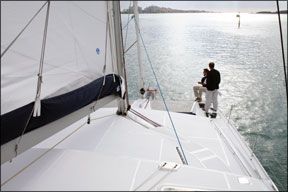There is a chance that our story on electric propulsion (starting on page 8) might be taken the wrong way. Our unequivocal “buyer beware” warning regarding this technology doesn’t mean that Practical Sailor doesn’t admire or respect the innovators in this field. Or that we don’t appreciate the financial risks many have

288
taken to advance the technology. Or that we don’t like the idea of being free of fossil fuels and the racket of engines that burn them.
However, at the end of the day, this publication has a duty to clear the air when the facts evaporate in a fog of irrational exuberance. Thanks to the support of you, our loyal subscribers who keep us ad-free, we are the only sailing publication that can poke holes in the emperors new boat without fear of being fed to the sharks.
So, just in case our message regarding electric propulsion is not clear, I will restate it here: Buyer beware. If a salesman buttonholes you at a boat show, explaining how his electric propulsion system will do everything a Yanmar 3JH3E can do without the smoke and smell, look him in the eye and ask him: “Show me the data.” And if he launches into a long-winded discussion of propellers and projected efficiencies at peak loads, explain that this is not what you mean.
The data we want is from real boats on real oceans. As far as Practical Sailor knows, there has been no conclusive head-to-head comparison between a hybrid or diesel-electric propulsion boat and the same boat (or sistership) under conventional diesel power. Practical Sailor invites such a comparison and will gladly report any data from an honest face-off between a conventional diesel and an electric propulsion motor.
The movement to replace the marine diesel with electric propulsion is struggling for a good reason: Marine diesel engines are very effective at what they do. Sure a diesel engine pumps carbon into the atmosphere and can seriously sully a bilge. But when youre trying to bash your way into a narrow cut against a headwind, it is one marvelous machine that has proven itself time and time again.
At this stage, the only practical application within reach of the average sailor is a charge-at-the-dock system, in which a quiet and relatively simple electric drive backed by batteries provides the limited power needed to get a small boat out to the bay for a daysail. Longevity of such a system remains to be seen, but it will do the job.
I have a much harder time relating to a system with a massive genset to power the electric drive units. Of course, the genset can support all kinds of homey comforts like ice makers and washing machines. But in my eyes, there is a much simpler, cheaper, and time-tested way to cope with noise, fumes, and sticker shock at the pumps: Hoist the sails and go sailing.
Darrell Nicholson
Editor
On the cover: A custom Crowther 47 with a Glacier Bay diesel-electric system entertains potential buyers in Miami. Photo courtesy of Glacier Bay.


































